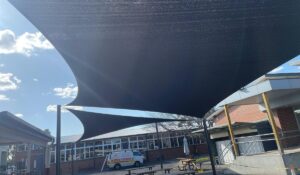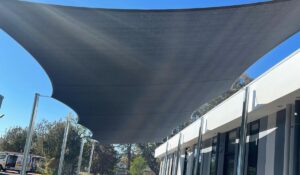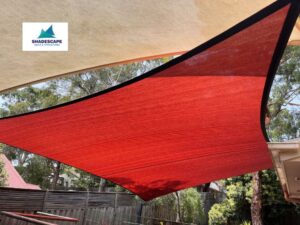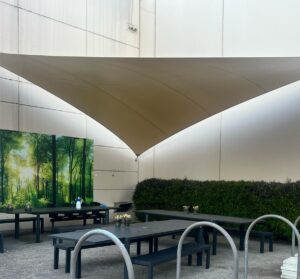Shade sails are an effective way to keep schools, parks, childcare centres, and other outdoor areas safe from the harsh Australian sun. Regular shade sail audits are needed, though, to make sure that shade sails remain effective, safe, and nice to look at. Even the best shade sails can start to break down due to the weather or normal wear and tear if they aren’t regularly cleaned and repaired.
In Victoria, where the weather shifts from hot summers to sudden storms, it is essential to regularly check your shade sails to ensure they’re still effective. This applies whether you run a school, a council, a daycare, or any public or private space.
At Shadescape, we are qualified and certified to conduct comprehensive shade sail audits for a diverse range of facilities, including schools, kindergartens, aged care centers, and councils. The following outlines the recommended audit frequency and key procedures.
Why You Should Regularly Perform a Shade Sail Audit
A shade sail audit checks to ensure that the sails are safe, work well, and still give enough shade. In Australia, the weather can be hot, and intense sun exposure. Regular inspections can help you find problems early and avoid having to pay for expensive repairs or replacements.
During a shade sail audit, inspect the fabric, tension, attachments, and supporting structures. Also, check for rust, storm damage, or other issues that could compromise the sails’ strength.
1. Annual Shade Sail Audit
One of the best ways to keep your shade sails in good shape is to have an annual shade sail audit. You should plan this before the summer heat hits, because that’s when the sails are most exposed to UV rays, which can damage the fabric over time.
During your yearly shade sail check, look for these things:
- Fabric wear and tear: Check for any tears, fading, or signs of UV damage.
- Tensioning system: Ensure that the sails are still taut and securely fastened.
- Fasteners and fixings: Inspect for rust or corrosion on bolts, ropes, and anchors.
- Mold or mildew: High humidity can cause mold, so look for growth on the fabric, especially if the sails are in shady or damp spots.
2. Post-Storm Shade Sail Inspections
Victoria is prone to storms, so inspecting shade sails after severe weather is necessary. Wind, hail, and rain may damage shade sails. After storms, inspect the following:
- Inspect for tears or holes in the fabric caused by strong winds or flying debris.
- Check the supporting structure: Make sure poles, anchors, and fixings are intact and not weakened by the storm.
- Look for pooling water: If water is collecting on the fabric, it could stretch or damage the material over time. Proper tension should allow water to drain off the sail.
3. Professional Shade Sail Audits Every 2-3 Years
While annual and post-storm audits can be done by yourself, a professional shade sail audit every 2–3 years is highly recommended. Shadescape professionals can perform a full inspection that goes beyond the basic checks. They can assess the overall installation, ensuring everything is still up to code and performing as it should.
A professional shade sail audit includes:
- In-depth inspection of the fabric, fasteners, and supporting structure.
- Recommendations for repair or replacement of any worn-out components.
- Safety checks to ensure compliance with Australian regulations, especially in public and commercial spaces.
4. Immediate Shade Sail Audits
There are times when you need to do an immediate shade sail audit, like when
- Sagging or loose sails: If the sails start to sag, it’s a clear sign that the tension is off, which could cause problems with the structure.
- Rust or corrosion on metal fasteners: Rust is a clear indicator that parts of your shade sail system are weakening.
- Water pooling: This indicates that the fabric is not adequately tensioned and could lead to damage if left unchecked.
Shade Sail Audit Guidelines: Best Practices
Here are some simple yet important shade sail audit guidelines to follow:
- Inspect the fabric: Check for any visible damage such as holes, fading, or signs of UV degradation. Fabric that looks thin or brittle may need to be replaced.
- Check the tension: Ensure the sails are still taut. Sagging can lead to issues such as water pooling, fabric stretching, or damage.
- Examine the fixings: Inspect the bolts, ropes, and other fastenings for rust or corrosion. These can weaken over time and need to be replaced.
- Look at the supporting structure: Ensure that poles and frames are firmly secured. Even a small amount of corrosion on metal poles can lead to a structural failure.
- Check for mold or mildew: These can form in humid or shady spots, especially after heavy rain or if the sails are rarely exposed to sunlight.
Obtaining Permission for Shade Sail Audits
In some cases, you may need permission before carrying out a shade sail audit, particularly if you manage a public space like a school or council building. It’s always best to check with local authorities or facility managers to ensure compliance with any regulations. This is especially important if you’re planning to make any significant repairs or replacements.
Why Choose Shadescape for Your Shade Sail Audits?
At Shadescape, we are proud to be qualified and certified professionals specializing in shade sail audits across various Australian facilities. Whether you oversee a school, kindergarten, aged care facility, or any other public space, we offer comprehensive inspections and recommendations to ensure your shade sails remain safe, secure, and in top condition.
By choosing Shadescape, you’re ensuring that your shade sails will stand the test of time, providing reliable protection for your community, students, or clients. Contact us today to schedule your shade sail audit and ensure your installations are safe and ready for the next season.
Frequently Asked Questions (FAQs)
- How often should I perform a shade sail audit in Victoria?
It’s recommended to perform a shade sail audit at least once a year, ideally before the summer season. This ensures that the sails are ready to withstand intense UV rays and potential storms. Additionally, perform inspections after any severe weather to check for storm damage.
- What is included in a shade sail audit checklist?
A shade sail audit checklist includes examining the fabric for any wear or UV degradation, ensuring the sails are properly tensioned, inspecting fastenings and fixings for rust or corrosion, checking the supporting structure for stability, and looking for any mold or mildew growth.
- How do I know if my shade sails need an audit?
You should consider a shade sail audit if you notice sagging fabric, rusted fasteners, water pooling on the sails, or visible damage after a storm. These are clear signs that your shade sails may need maintenance or repairs.
- Can I perform a shade sail audit on my own?
You can perform basic checks yourself, such as inspecting for visible damage, sagging, or rust. However, it’s recommended to have a professional shade sail audit every few years to ensure all structural and safety elements are properly inspected and maintained.







